A new rhythm
Dance benefits Parkinson's patients
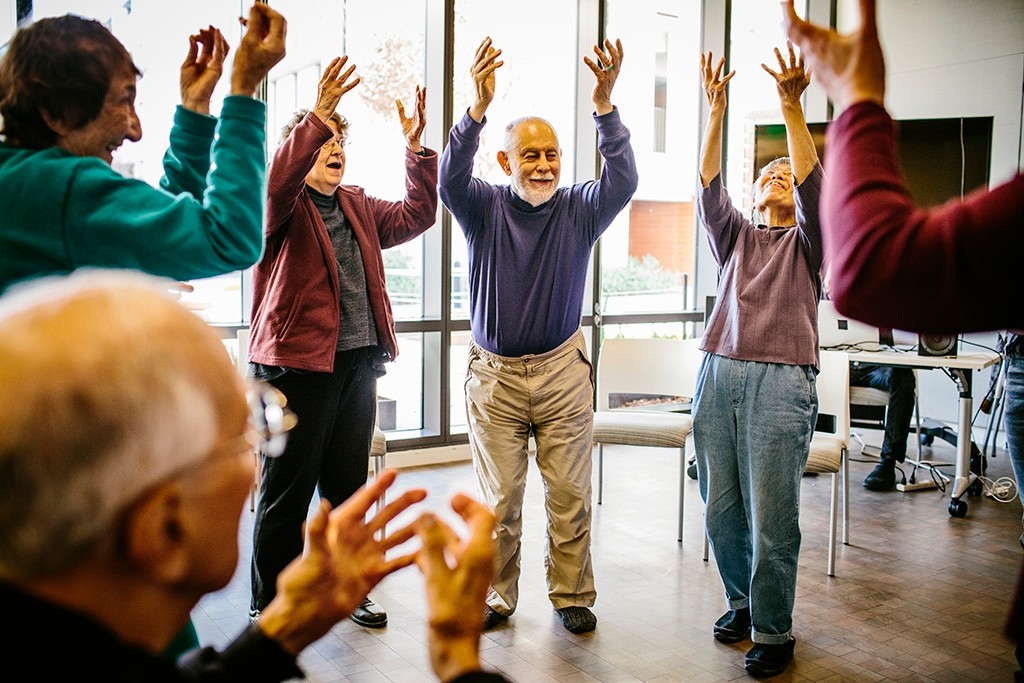
Sherry Brown walks gingerly into the dance class, her right elbow anchored at her side, her hand cupped in a ball. Her balance is uneven, so she takes care in finding a seat among the circle of chairs in the light-filled room at the Stanford Neuroscience Health Center. As the slow, rhythmic keyboard music begins, her arms, stiffened by Parkinson’s disease, open in a wide, upward arc as if embracing the sky.
“You get a sense of your body and are pushing your body to do things you don’t think you can accomplish,” says Brown, who was diagnosed in 2008 with the neurodegenerative disease. “There is something about the music and movement together that seems to help at a different level. … I come out of the class feeling energized and relaxed, all at the same time, and ready to move.”
Brown is among some 20 students who have found a welcoming community at the Dance for Parkinson’s Disease class, also known as Dance for PD. The class is not only physically therapeutic but often gives students a psychological boost. People struggling with movement and speech because of the disease say the sessions are liberating, providing a new way to express themselves.
The program, begun 15 years ago in Brooklyn, New York, and now offered in 16 countries, was introduced at Stanford last year with the opening of the new neuroscience center. It is not a traditional dance class in any sense, but rather a group artistic experience.
Teachers use elements of classic and social dancing, together with imagery, poetry and live music, to inspire participants to move in creative ways. The results translate into daily life, studies show, as participants demonstrate an improvement in walking and fine-motor skills, such as tapping a finger, and feel an uplift in mood and a better sense of self that comes from gaining more physical control.
“Dancing has all the elements Parkinson’s patients can benefit from: extension and flexibility and moving with intention,” says Damara Ganley, a professional dancer and trained Dance for PD instructor. “Dancers are trained to be in their bodies in a conscious way, and Parkinson’s patients also are learning to be in their bodies in a conscious way.”
Brown, 74, gray-haired and slender, is a marriage and family therapist who maintains an active social life despite her physical challenges. She says the disease crept up on her, gradually narrowing her world. Her movements became slower, more labored, and she no longer easily stood straight. She began to feel some weakness in her right hand, which would tire after writing a few words. She would easily lose her balance and began to have debilitating falls, including one in which she broke her hip and another in which she struck her head on a rock while sweeping the walk outside her home. When she was diagnosed with Parkinson’s, she says, she fell into despair.
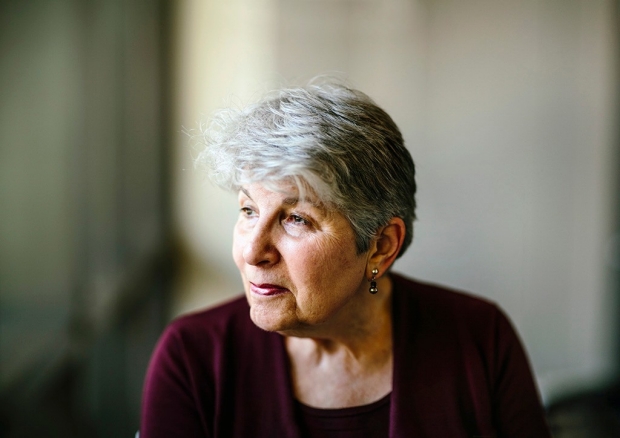
“I definitely went through a grieving period. I felt like my life was over,” she says over a cup of tea at her dining room table. She now has a part-time personal assistant who helps around the house, though she is able to prepare the tea herself.
Parkinson’s, which affects as many as 10 million people worldwide, can cause rigid limbs, tremors, lack of muscle control and slowed movement. Patients may have impaired walking and balance and are more prone to falls. Some also suffer from depression and may experience a cognitive decline, with slowed thinking or memory problems.
Brown says daily tasks became a challenge, as she could no longer stab a piece of lettuce with a fork, handle a pair of scissors or easily get up out of a chair. She stopped accepting new referrals to her therapy practice. She no longer drove on the freeway and began to miss out on important social occasions because of disease-related fatigue.
“I spent about a year really being aware of all the losses,” she says.
Gradually, however, her life began to open up again as she came to a place of acceptance and began to improve physically with the help of new medication, physical therapy, fitness training, daily walks — and dance.
On the move
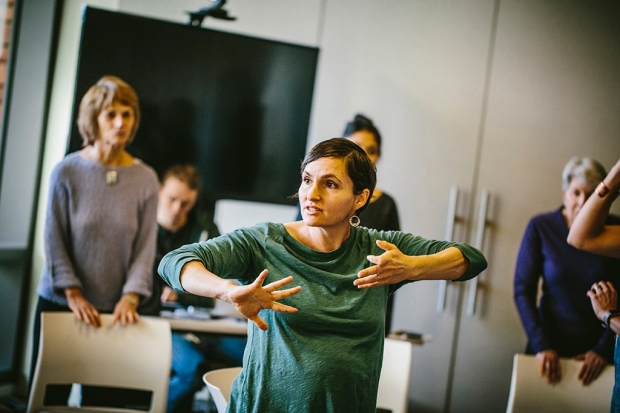
During a recent Friday session, Ganley, a petite woman with short-cropped hair, opens with some gentle stretching exercises in the chair, as the keyboardist plays his own rhythmic composition, which has an ethereal quality. Participants, seated in a circle, cross their feet back and forth, then move one foot to the right while gesturing to the left. The sequence is repeated on the opposite side, requiring focused concentration.
“That tickled my brain,” Ganley says with a smile. Then she begins a sequence of movements to the lyrics “Autumn leaves are falling, falling” as the dance students join in, rolling their hands in space like leaves being tossed in the wind, then gently falling down.
The class has many interactive moments, including one in which the instructor prods the students to “say something with the body” to a neighbor in the circle, who responds in kind. The exercise is repeated with a different partner, and the results then are displayed for the entire class. “Beautiful,” Ganley says as heads nod.
On this day, the 75-minute session includes other improvisational exercises, as well as a traditional Israeli circle dance with a rather challenging series of steps. It closes with dancers individually calling out their names, then using a gesture to express what they are grateful for. Some blow kisses; others use a sweeping move of the arm to encompass everyone in the room. “Each of us is a living poem to be savored and acknowledged,” Ganley says.
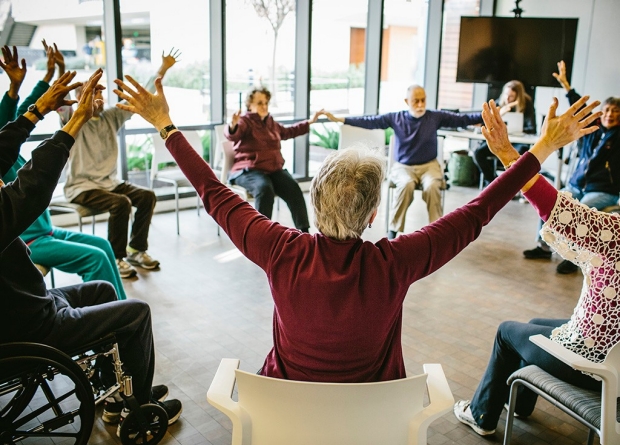
Brown, neatly dressed in black pants and a tailored shirt, says the class has a mindful, meditative quality. “It’s totally creative and totally accepting of whatever your abilities are,” she says.
With her new medication regimen and her physical activities, she is able to do many things that weren’t possible before. For instance, in one class, she found she could again stand on her toes and keep her balance. And during a flamenco dance routine, she found herself snapping her once-rigid fingers. “It just came to me,” she says. The dance class “challenges you in ways you would not have thought possible.”
The class also has helped improve the fluidity of her movements. “I think the rhythm helps keep things more even. I feel my gait is more even. In general, my body feels more in tune — more rhythmic. It’s subtle.
“I think it has helped me a lot to appreciate what I can do — big and little things both,” she adds. “I feel that with all things I am doing — the exercise, the dance, the medications — I am definitely delaying the severe symptoms of the disease. I am pleased that I am able to have the life that I have at this point.”
‘The PD dancers have told us that this type of dance restores their self-image and brings them joy.’
The program was started in 2001 by Olie Westheimer, executive director of the Brooklyn Parkinson Group, who walked into the Brooklyn studio of the Mark Morris Dance Group one day with the idea of creating a dance class for members of her group, says David Leventhal, a former Mark Morris company member who is now Dance for PD’s program director. Westheimer felt patients were spending a lot of time dwelling on the disease and shuttling to doctors’ and therapists’ offices, and she wanted them to do something positive and beneficial together. Leventhal became one of the first instructors.
“I thought it was the most enjoyable teaching experience I had ever had because people were so focused on learning and trying to absorb as much as we had to offer,” Leventhal says. “They were so engaged as students right away because for them it was not just an activity they added to their week but an essential portal for them to experience what possibilities were still available to them. It became a way of accessing their true selves — who they were as people, rather than as patients.”
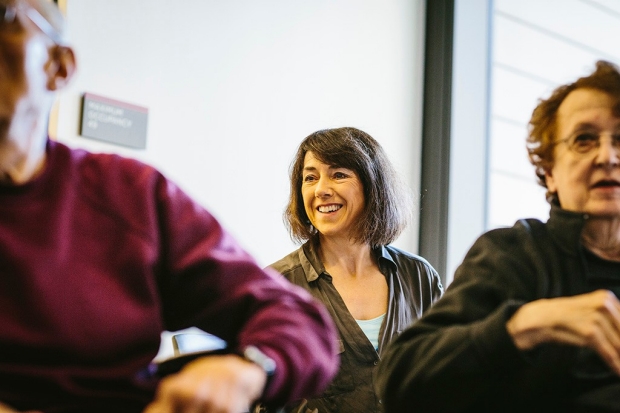
Helen Bronte-Stewart, MD, a Stanford professor of neurology and neurological sciences and a former professional dancer, says she has always tried to incorporate exercise, yoga and dance as part of the standard therapy for her Parkinson’s patients.
“If you improve your core strength, then the negative effects like difficulty of getting out of chairs, getting out of a car, will be better,” says Bronte-Stewart, who refers to the process of exercise and balance training as “training the machine.”
“You have to keep training that motor system — training the brain — as a way of continuing movement in a disease that otherwise limits movement, counteracting the stiffness and slowness that the brain wants to impart on the musculoskeletal system,” she says.
“As physicians, we stress the importance of physical activity, social interaction and mental stimulation to our patients with Parkinson’s disease,” she adds. “Dance for PD gives them all three. But it is much more than a possible therapy or treatment; the PD dancers have told us this type of dance restores their self-image and brings them joy.”
When the neuroscience building was in the planning stages, Bronte-Stewart says she was determined to include a dance studio and helped design the space with a flexible floor and glass walls on two sides. She and Ganley obtained a grant from the National Parkinson Foundation for the class, which is free and is open to all in the community.
“The worlds of dance and medicine have been far apart for a long time. That is why this is so exciting,” Bronte-Stewart says. “If you have a chronic debilitating disease, you begin to get an image of yourself as someone who can’t move. But you can go to this class and do something beautiful and graceful and be part of a community that accepts you. That is what we should capture, as much as whether your motor function is better.”
Backed by research
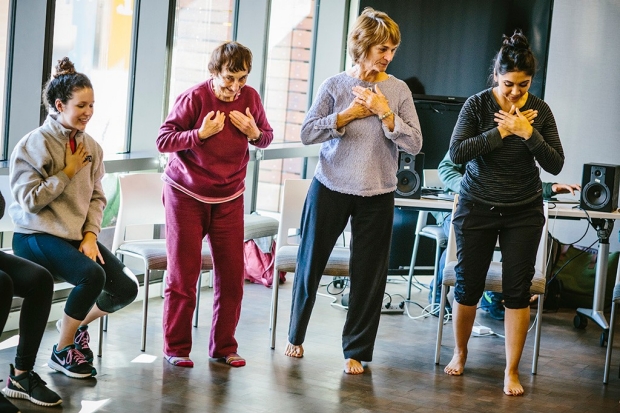
Leventhal says the program initially met with some skepticism in the medical community. “There was one neurologist who told us, ‘I think the program is great. But I can never recommend it because dancing is a frivolous activity and that would tarnish my reputation as a serious doctor,’ ” he says.
“There is a lot of misconception about the amount of learning and skill and brain work and physical work that somebody has to do to execute a dance. It’s the opposite of frivolous. It directly addresses what people are struggling with. Over 15 years, people have come to recognize that.”
In fact, published studies have shown that Parkinson’s patients who do some form of dance experience measurable physical and psychological improvements. More than a dozen studies have shown that twice-weekly dance classes improve balance, motor skills, freedom of movement and endurance.
One study, published in 2011 in Frontiers in Aging Neuroscience, found that even after a single class, patients were able to move their limbs more easily, tap their fingers and change their facial expressions. (Loss of facial muscle control can lead to muted expression.) The study participants also described many improvements in the quality of their lives, with one saying, “I want to fly. It gives me a swinging feeling. I feel relaxed after the dance lesson. Before, I’m always very stiff.”
Research suggests dance has benefits beyond basic exercise for these patients because it is a rich experience involving multiple senses, creative expression and social interaction. Moreover, unlike exercise classes, participants are motivated to attend, rarely missing a class and often clamoring for more, studies show.
“People tell us, ‘I always look forward to coming to class because it’s so uplifting,’ ” Bronte-Stewart says.
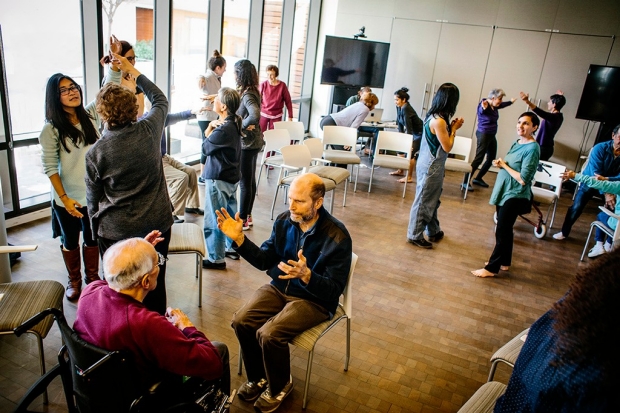
She says dance is a form of mental as well as physical training. “When you think of it as a neurologist, they are planning, using their executive function and they are sequencing. These are all frontal-lobe functions that can be impaired in Parkinson’s.”
Bronte-Stewart says animal studies suggest there may be a biological basis for improved neurologic function among dance participants. For instance, research shows that if animals are able to do a physical activity they enjoy, they experience less inflammation, which may help counter the disease, and are able to regenerate adult stem cells, which can help build muscle and other tissues.
“It’s not too much of a stretch to suggest that dance possibly may improve the brain’s regeneration of its own stem cells,” she says.
Dance classes may also counter some of the cognitive and mood issues that affect patients, who may withdraw and suffer social isolation and poor self-esteem. The classes provide a social setting where everyone is accepted, regardless of their limitations, and studies show participants feel their mood lighten and their anxiety decline. In a 2015 study published in Journal of Neural Transmission by Westheimer and colleagues from four universities, participants reported feeling less helpless, grateful for the companionship and a general sense of improved health.
Albert Cohen, one of the Stanford dance students, says he appreciates the sense of camaraderie and caring among the students. “The attitude there is positive and receptive, which is worth a lot,” says Cohen, 87. “I’m not sitting in a room doing nothing. So it’s very beneficial.”
A musicologist and former chair of Stanford’s Department of Music, Cohen suffered a major fall in the summer that fractured his hip and pelvis. When he and his wife, Betty, returned after a two-month hiatus, class members embraced them with hugs and good wishes. Betty Cohen says the gathering is the highlight of her week.
“You’re getting out. You’re with other people. You are exposed to music, which helps the brain. There is rhythm and movement. I think all of this is helpful,” she says. “It really is more than the dance and the music. It’s greater than the sum of its parts. Something emanates from the heart and soul. It helps me emotionally accept everything that I’m finding hard to accept.”
Caregivers are encouraged to attend the classes to support their partners and to share a positive experience. “I think the class allows care partners to see their loved ones and companions in a different light and enjoy an hour together when they are not dealing with the struggle of daily life but see each other as dance partners and as co-learners. That’s very important,” Leventhal says. Stanford medical students and undergraduates also participate in the class through specially designed coursework.
‘There is something about the music and movement together that seems to help at a different level.’
Juan Bulnes, who was diagnosed with Parkinson’s in 2008, regularly attends class with his wife, Margaret. He often does the movements in his chair, as he is shaky on his feet and afraid he will fall, he says.
“There is joy in the dancing class,” says Bulnes, a 74-year-old computer scientist. “We do some of the same movements as in other classes, like tai chi or physical therapy, and here we do them with an added, special flair that comes from conscious dance movements, such as gracefully waving your hands to imitate falling leaves, rain, wind or reaching for the stars. Integrating physical exercise, rhythm, music and imagination makes dancing a very liberating experience.”
Making it more accessible
Leventhal, who gave up performing five years ago to devote all of his time to the project, has been making the program more widely available and providing opportunities for practice between classes. The flagship Dance for PD program in New York has developed three DVDs, which have been distributed to 4,000 people worldwide, and last year began live streaming classes from Brooklyn and Toronto.
Mark Morris Dance Group, together with the New York creative agency SS+K, has also created Moving Through Glass, custom software for use on the Google Glass platform to help Parkinson’s patients navigate the world outside the dance studio. The application enables users wearing the device — a head-mounted display in the form of a pair of eyeglasses — to play modules in which Mark Morris dancers give prompts, taking them through home exercises to help with specific problems, like regaining balance or unfreezing the limbs. The app is being evaluated at three locations around the country, including Stanford, where Bronte-Stewart has recruited dance class participants to try it out.
Dance for PD, meanwhile, is becoming a widely accepted form of Parkinson’s therapy. Stanford recently added a second class that meets on Monday afternoons.
Sherry Brown attends both the Monday and Friday sessions, as she is determined to do what she can to forestall any further physical decline. “I do have fears about the future and there’s nothing I can do about that. I like to stay in the present as much as I can,” she says.
The dance class helps set aside her fears, at least for the moment. “It has helped me adjust to the future. It becomes a little less scary about the unknown, seeing other people go through it,” she says. “It focuses you on the present, and the rest of your worries fade into the distance. You are focused on the here and now.”

